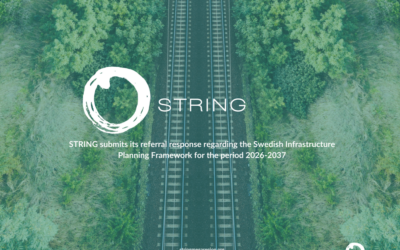11/10/21
The 350 km stretch of railway currently connecting Oslo and Gothenburg, has been identified as a major bottleneck for effective transportation of goods and passengers. Currently 60% of the distance between the two cities, is single-track – resulting in unnecessarily long travel times for goods travelling along the corridor, and making rail an unattractive option in many instances. The expansion of the link to double-tracks all the way, could help alleviate these problems and bring with it a wide array of benefits, not only for the companies utilizing the link, but also for individuals and the climate in general.
A recent report published by TØI, the Norwegian Institute of Transport Economics, models this exact scenario, and the benefits are substantial. According to report, the expansion of the stretch to include double-tracks throughout, would result in travel times, for goods, being reduced from 7,5 hours, down to 4 hours – making it competitive with other alternative modes of transportation such as road transport. This in turn, brings with it a whole range of benefits – both economic, environmental, and individual.
The report estimates that the present value of the project benefits could be to the tune of 776 million NOK, over a 40-year period. Time is money, so nearly halving transportation time would be a major economic boost for the industries affected. Furthermore, the completion of the project would result in a reduction in emissions of up to 289,000 tons of CO2, over the first 2 decades of the project. To put this number in perspective, it would require the removal of more than 70.000 passenger vehicles for a full year, to achieve similar reductions. The expansion of the track, would also mean direct benefits to the individual residing in the affected areas. Making rail a more attractive alternative to road transportation, would mean less congestion on the roads, fewer accidents and a significant reduction to local pollution, therefore improving air quality.
The publication of the report comes at a crucial time – EU has announced that they aim for more than 70% of all freight to be transported via rail within the coming years. This has resulted in large amount of investment pouring into infrastructure, in an attempt to meet this target. The more common rail transport becomes in the surrounding countries, that both Sweden and Norway depend upon as markets of export, the higher the chance that Sweden and Norway will be at a competitive disadvantage, and function as a bottleneck for development and green transition.
In short, the time to invest in order to reap the benefits of transition to sustainable modes of transport is now. Not only for the benefits listed above, but in order to stay connected to crucial markets and remain competitive on an international scale.
Read the full report here: Double-track railway between Oslo and Gothenburg – An analysis using the Norwegian Freight Transport model – Transportøkonomisk institutt (toi.no)
About STRING:
STRING is a geographical area and a political member organisation in Northern Europe. We connect cities and regions to collaborate effectively, share knowledge and implement integrated policies to deliver on United Nations’ Sustainable Development Goal 11: Sustainable cities and communities. Representing some of the world’s most innovative cities and regions, STRING has a unique opportunity to lead the way towards a sustainable future.
About TØI:
TØI stands for The Institute of Transport Economics. The main objectives of the Institute are to carry out applied research on issues connected with transport and to promote the application of research results by advising the authorities, the transport industry and the public at large. Its sphere of activity includes most of the current major issues in road, rail, sea and air transport.



